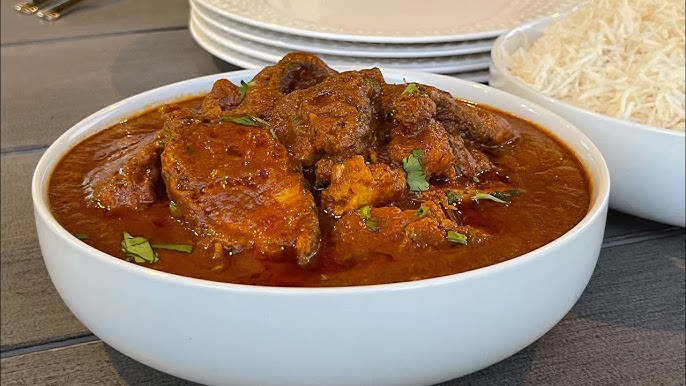Fish Curry Recipe: When you think of comfort food that is rich in flavor, aromatic, and deeply satisfying, fish curry easily comes to mind. This dish has made its mark across the globe, from the coconut-rich curries of South India to the tangy mustard fish curries of Bengal, and even the spicy versions popular in Southeast Asia. Fish curry isn’t just food; it’s a delightful journey of flavors, textures, and traditions that have been passed down for generations.
In this guide, we’ll explore everything from the essential ingredients you’ll need to the step-by-step process of creating the perfect fish curry. Whether you’re a beginner in the kitchen or an experienced cook looking to refine your skills, this recipe will guide you through each step with precision.
Why Fish Curry is Loved Worldwide
Fish curry is adored not only in Asia but also in various corners of the world because of its versatility and comforting taste. Every culture brings its own twist—whether it’s the creamy coconut-based curries from Kerala, the tangy tomato-based curries from Sri Lanka, or the spicy pepper-laden versions from Thailand. The common thread is the love for combining tender, juicy pieces of fish with aromatic spices simmered in a flavorful gravy. Unlike meat curries, fish curries cook quickly, making them a go-to choice for busy weeknights. Beyond convenience, they carry an irresistible home-cooked charm, the kind that reminds you of family gatherings and coastal vacations.
Fish is also incredibly adaptable, allowing you to play with various bases—tomato, tamarind, coconut, or yogurt—to match your mood and taste. This adaptability, combined with the light yet satisfying nature of the dish, explains why fish curry remains a timeless favorite across generations.
Health Benefits of Eating Fish Curry
Fish curry isn’t just delicious—it’s also a powerhouse of nutrition. Fish itself is rich in lean protein, making it perfect for maintaining muscle health without the heaviness of red meats. It’s also a great source of omega-3 fatty acids, which are vital for heart health, brain function, and reducing inflammation in the body. Adding spices such as turmeric, garlic, and ginger further enhances its health value since these ingredients are known for their anti-inflammatory and antioxidant properties.
Another benefit lies in its versatility: you can make fish curry lighter with less oil and a tomato base, or richer with coconut milk or cream. This means you can tailor the dish to fit your dietary needs without compromising taste. For anyone who’s looking for a wholesome meal that satisfies the taste buds and nourishes the body, fish curry is a fantastic choice.
Ingredients You’ll Need
The beauty of fish curry lies in its simplicity. With a few pantry staples and fresh produce, you can create a dish bursting with flavor. Below is a comprehensive list of what you’ll need.
Fresh Fish Selection
The star of the dish is, of course, the fish. You can choose from a variety of options depending on availability and preference. Commonly used fishes include:
- Salmon – tender and fatty, adds richness.
- Tilapia – mild and budget-friendly.
- Kingfish (Surmai) – firm and perfect for curries.
- Mackerel – bold and flavorful.
- Catfish – meaty and holds well in gravy.
When selecting fish, always opt for fresh cuts with a clean smell and firm flesh. Boneless fillets are great for beginners, but traditional recipes often use bone-in pieces for added depth of flavor.
Essential Spices and Herbs
No curry is complete without spices. The essentials for a fish curry include:
- Turmeric powder
- Red chili powder
- Coriander powder
- Cumin seeds or powder
- Garam masala (optional, for richness)
- Mustard seeds (especially in South Indian curries)
- Curry leaves (for fragrance)
- Fresh ginger and garlic
These spices form the backbone of the curry, creating layers of heat, warmth, and aroma.
Vegetables and Base Ingredients
To build the base, you’ll need:
- Onions (finely chopped)
- Tomatoes (ripe and juicy)
- Green chilies (for heat)
- Fresh coriander leaves (for garnish)
For creaminess, coconut milk or yogurt is often used, depending on the regional style of curry you’re making.
Optional Add-ons for Extra Flavor
Want to elevate your curry? Try these add-ons:
- Tamarind pulp for tanginess.
- Fenugreek seeds for a slightly bitter depth.
- Fresh grated coconut for added body.
- A squeeze of lemon juice before serving for brightness.
Preparing the Ingredients
Before the cooking begins, preparation is key. Properly prepped ingredients ensure that the cooking process is smooth and the final curry comes together beautifully.
Cleaning and Cutting the Fish
Start by washing the fish pieces thoroughly under cold water. If you’re using whole fish or steaks, remove any scales and clean the insides properly. For fillets, simply rinse and pat dry. Cut the fish into medium-sized chunks—too small, and they’ll break in the curry; too large, and they won’t absorb enough flavor. Sprinkle a little salt and turmeric over the pieces as a pre-marination step to keep them fresh and flavorful.
Preparing the Spice Mix
Many seasoned cooks prefer to grind their spice mix fresh. You can do this by blending garlic, ginger, and green chilies into a paste. In a small bowl, mix powdered spices such as turmeric, chili powder, and coriander with a bit of water to form a slurry—this prevents the spices from burning when added to hot oil later. This step may seem small, but it ensures your curry develops a smooth, rich flavor without bitterness.
Chopping Vegetables and Herbs
Finely chop onions and tomatoes, as these form the curry base. Onions add sweetness, while tomatoes balance the curry with acidity. Fresh coriander leaves should be roughly chopped for garnish. Keep curry leaves ready as they need to be added whole for maximum aroma. By prepping these in advance, you’ll find the actual cooking process effortless.
Step-by-Step Guide to Cooking Fish Curry
Cooking fish curry is about layering flavors. Unlike other curries that need hours of simmering, fish curry is relatively quick but requires careful attention to timing.
Step 1 – Marinating the Fish
Begin by marinating the fish pieces. A simple marinade of turmeric, salt, and lemon juice works wonders. If you want a deeper flavor, you can add ginger-garlic paste and chili powder. Marinate for at least 20 minutes. This step not only infuses flavor but also helps prevent the fish from breaking apart while cooking.
Step 2 – Preparing the Curry Base
Heat oil in a deep pan or pot. Add mustard seeds (if using), followed by curry leaves, and let them crackle. Toss in the chopped onions and sauté until golden brown. Add ginger-garlic paste and fry until fragrant. Next, stir in the spice slurry you prepared earlier. Once the raw aroma fades, add tomatoes and cook until they turn soft and oil begins to separate. This forms the perfect masala base for your curry.
Step 3 – Cooking the Fish in the Curry
Pour water, tamarind extract, or coconut milk into the base, depending on the style of curry you’re making. Let the mixture simmer gently. Carefully add the marinated fish pieces. Avoid stirring too much at this stage—just swirl the pot gently so the fish absorbs the flavors without breaking apart. Cook on low heat for about 8–10 minutes, until the fish is just done.
Step 4 – Adjusting the Consistency and Seasoning
Taste the curry and adjust salt, spice, or tanginess as needed. If it’s too thick, add a splash of water or stock; if too thin, let it simmer uncovered for a few extra minutes. The curry should be rich but pourable, coating the fish beautifully. Garnish with fresh coriander leaves and a squeeze of lemon juice before serving hot with rice or flatbreads.
Tips and Tricks for the Perfect Fish Curry
How to Avoid Overcooking Fish
One of the biggest mistakes in fish curry is overcooking the fish, which makes it tough and rubbery. Always cook on low to medium heat and add fish towards the end of the process. Remember, fish cooks faster than you think—usually within 8–10 minutes.
Balancing Spices for Different Palates
Not everyone enjoys the same level of heat. To make your curry more family-friendly, reduce chili powder and increase the use of aromatic spices like coriander and cumin. For those who love it fiery, add extra green chilies or a spoon of chili oil before serving.
Making the Curry Rich and Creamy
For a luxurious texture, stir in coconut milk, cream, or cashew paste at the end of cooking. If you prefer a lighter curry, stick to tomato or tamarind bases. Adjusting these elements lets you create endless variations while still keeping the essence of fish curry intact.
Serving Suggestions for Fish Curry
Fish curry isn’t just a dish—it’s the centerpiece of a meal. How you serve it can elevate the dining experience from good to unforgettable. Traditionally, fish curry is paired with steamed white rice, which soaks up the flavorful gravy and balances the spices. But that’s only the beginning. Let’s explore the many ways you can serve this delicious curry.
Rice Pairings
- Steamed Basmati Rice: Long, fluffy grains that absorb the curry beautifully.
- Jeera Rice: Flavored with cumin seeds, this adds an earthy aroma.
- Lemon Rice: A tangy South Indian favorite that complements spicy curries.
- Brown Rice: For a healthier alternative, offering more fiber.
Bread Options
While rice is the classic partner, bread can be equally satisfying. Serve your curry with:
- Chapati or Roti: Soft flatbreads that soak up the sauce.
- Parathas: Buttery, flaky layers add indulgence.
- Naan: Chewy and slightly charred, perfect for rich curries.
Side Dishes
- Papadums: Crispy and light, a great contrast to the rich curry.
- Pickles: Spicy mango or lime pickles intensify the flavor.
- Salads: A cucumber-tomato-onion salad provides a cooling touch.
Pairing wisely enhances not just the curry but the entire meal, turning it into a memorable dining experience.
Regional Variations of Fish Curry
Fish curry is a global treasure, and each region adds its own flair. From India to Thailand, the variations are endless. Let’s take a quick culinary tour.
South Indian Fish Curry
This version often uses coconut milk, curry leaves, and tamarind. It’s spicy, tangy, and aromatic. Kerala’s meen curry is a shining example.
Bengali Fish Curry (Machher Jhol)
Bengalis prefer freshwater fish like rohu or hilsa. The curry is light, often made with mustard oil, turmeric, and potatoes for extra body.
Goan Fish Curry
Goa’s version is rich and tangy, thanks to the combination of coconut milk, kokum, and fiery red chilies. It’s often paired with steamed rice.
Sri Lankan Fish Curry
Known for bold flavors, this variation uses roasted spices, coconut milk, and lots of chilies. It’s darker, richer, and has a smoky undertone.
Thai Fish Curry
Moving beyond India, Thai versions incorporate lemongrass, kaffir lime leaves, and Thai curry pastes. They’re creamy, fragrant, and often served with jasmine rice.
Each style has its charm, making fish curry a dish that feels both local and universal at the same time.
Common Mistakes to Avoid When Cooking Fish Curry
Even the most experienced cooks can slip up when making fish curry. Being aware of common mistakes ensures your dish comes out perfect every time.
Overcooking the Fish
This is the number one mistake. Remember: fish cooks quickly. Always add it toward the end and cook on gentle heat.
Using Too Much Water
Adding excess water dilutes the flavors and makes the curry thin. Always add water gradually and allow the curry to simmer until it thickens naturally.
Skipping the Spice Tempering
Many beginners add spices directly into the curry without sautéing them. Dry spices should always be fried in oil or ghee to release their full aroma before mixing into the base.
Choosing the Wrong Fish
Delicate, flaky fish can disintegrate in curry. Always pick firm fish like kingfish, mackerel, or salmon that can withstand cooking.
Not Balancing Flavors
Too tangy, too salty, or too spicy can throw off the dish. Always taste and adjust seasoning before finishing.
Avoiding these mistakes helps you achieve a curry that’s flavorful, balanced, and restaurant-quality.
Health Benefits of Fish Curry
Fish curry isn’t just delicious—it’s also a smart choice for those who want nutritious meals without sacrificing taste.
Rich in Lean Protein
Fish provides high-quality protein that helps build muscles, repair tissues, and keep you full longer without the heaviness of red meat.
High in Omega-3 Fatty Acids
Omega-3s are essential fats that support brain function, reduce inflammation, and promote heart health. Fatty fish like salmon and mackerel are especially rich sources.
Packed with Spices Full of Health Benefits
- Turmeric: Anti-inflammatory and great for immunity.
- Ginger & Garlic: Support digestion and heart health.
- Chilies: Boost metabolism and circulation.
Low-Calorie Yet Satisfying
Unlike heavy meat-based curries, fish curry can be light yet filling, making it perfect for those watching their weight.
Supports a Balanced Diet
Pair it with rice or whole grains, and you’ve got a complete meal rich in protein, fiber, vitamins, and minerals.
Eating fish curry regularly can improve overall well-being while letting you indulge in incredible flavors guilt-free.
How to Store and Reheat Fish Curry
Sometimes, fish curry tastes even better the next day because the flavors deepen as they sit. However, storing and reheating it correctly is key to keeping the fish tender and the curry fresh.
Storing Fish Curry
- Cool Before Storing: Let the curry come to room temperature before refrigerating. Storing it hot can cause bacterial growth.
- Use Airtight Containers: Place the curry in a clean, airtight container to avoid cross-contamination and prevent odors from spreading in the fridge.
- Refrigeration: Properly stored, fish curry lasts up to 2 days in the refrigerator.
- Freezing: If you want to store it longer, separate the curry base from the fish pieces. Freeze the base for up to 2 months and add fresh fish when reheating.
Reheating Fish Curry
- Stovetop Method: Warm the curry gently over low heat. Avoid boiling as it can overcook the fish and make it rubbery.
- Microwave Method: Heat in short intervals (1–2 minutes), stirring in between. Cover the container to avoid splattering.
- Pro Tip: Add a splash of water or coconut milk while reheating to restore the curry’s consistency and freshness.
Handled properly, leftover fish curry can be just as enjoyable, if not more flavorful, than when freshly made.
Pairing Drinks with Fish Curry
Choosing the right drink with your meal can enhance the curry experience. Since fish curry is often spicy and rich, you’ll want beverages that complement and balance the flavors.
Non-Alcoholic Options
- Buttermilk (Chaas): A cooling Indian classic that soothes spice.
- Fresh Coconut Water: Refreshing and tropical, perfect for coconut-based curries.
- Lassi (Sweet or Salty): Yogurt-based drinks that reduce heat from chilies.
- Herbal Teas: Ginger or mint tea pairs surprisingly well.
Alcoholic Options
- White Wine: A crisp Sauvignon Blanc or Riesling balances the heat and tang.
- Beer: Light lagers and wheat beers cut through the spice without overwhelming flavors.
- Cider: Fruity notes add a sweet counterpoint to savory curries.
Pairing thoughtfully ensures your meal feels complete, making every bite and sip harmonious.
Fish Curry for Beginners: Quick Version
If you’re short on time or new to cooking, here’s a simplified version of fish curry that still packs a punch of flavor.
Ingredients (Quick Version)
- 500g fish fillets (tilapia or salmon)
- 2 medium onions (chopped)
- 2 tomatoes (chopped)
- 2 tsp ginger-garlic paste
- 1 tsp turmeric powder
- 1 tsp chili powder
- 2 tsp coriander powder
- 1 can coconut milk
- Fresh coriander leaves
Steps
- Heat oil, sauté onions until golden.
- Add ginger-garlic paste and cook until fragrant.
- Stir in turmeric, chili, and coriander powders.
- Add tomatoes, cook until soft.
- Pour in coconut milk and simmer.
- Gently add fish fillets and cook for 8 minutes.
- Garnish with coriander leaves and serve hot.
This quick version skips elaborate steps but still delivers a flavorful curry in under 30 minutes. Perfect for busy weeknights!
Fish Curry vs. Other Curries
Fish curry stands apart from chicken, lamb, or vegetarian curries in several ways.
Cooking Time
- Fish Curry: Quick, usually 20–30 minutes.
- Chicken or Meat Curries: Longer, often 1–2 hours for tender results.
Flavor Profile
- Fish Curry: Light, tangy, and aromatic.
- Meat Curries: Rich, heavy, and spiced deeply.
Nutritional Value
- Fish Curry: Lower in calories, high in omega-3s.
- Meat Curries: Higher in fat, protein-dense.
Versatility
- Fish curry can be adapted with coconut milk, tamarind, or mustard bases.
- Other curries often rely on tomato or onion gravies as a foundation.
If you want something nutritious, flavorful, and quick, fish curry easily takes the crown over other options.
FAQs about Fish Curry Recipe
1. Can I make fish curry without coconut milk?
Yes! You can use tomatoes, yogurt, or tamarind as the base instead.
2. What’s the best fish for curry?
Firm fish like kingfish, salmon, or mackerel work best because they hold shape while cooking.
3. Can I prepare fish curry in advance?
Yes, but it’s better to store the curry base separately and add fish fresh when reheating.
4. How do I reduce the spiciness if it’s too hot?
Add coconut milk, cream, or a squeeze of lemon juice to mellow the heat.
5. What should I serve with fish curry?
Steamed rice, naan, or parathas pair wonderfully with fish curry.
Conclusion
Fish curry is more than just a recipe—it’s an experience that blends tradition, nutrition, and unforgettable flavors. Whether you’re making a quick weeknight curry or indulging in a slow-cooked regional variation, the dish never fails to satisfy. With the right ingredients, careful cooking, and a few expert tips, anyone can master this beloved classic.
So, the next time you crave a comforting, flavorful, and nourishing dish, let fish curry take center stage on your dining table.



